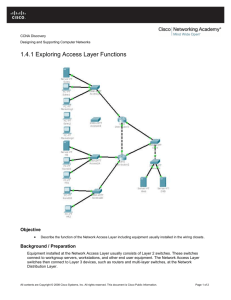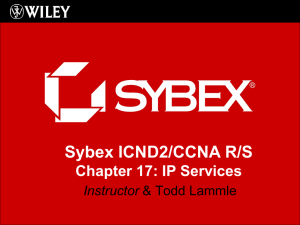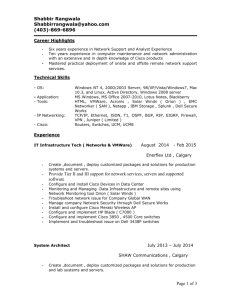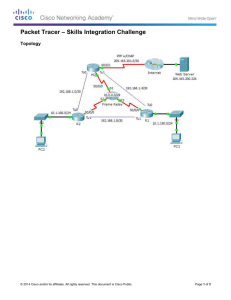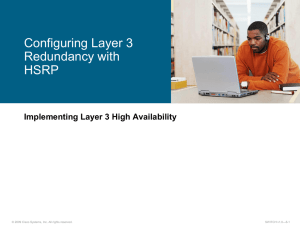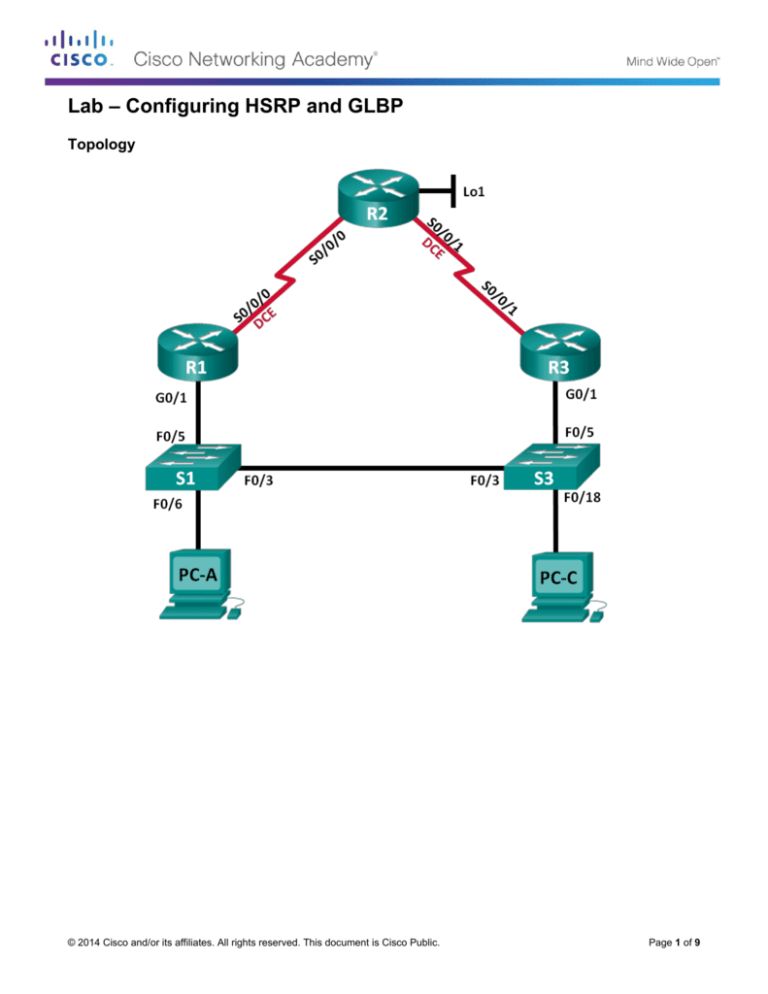
Lab – Configuring HSRP and GLBP
Topology
© 2014 Cisco and/or its affiliates. All rights reserved. This document is Cisco Public.
Page 1 of 9
Lab – Configuring HSRP and GLBP
Addressing Table
Device
R1
Interface
IP Address
Subnet Mask
Default Gateway
G0/1
192.168.1.1
255.255.255.0
N/A
S0/0/0 (DCE)
10.1.1.1
255.255.255.252
N/A
S0/0/0
10.1.1.2
255.255.255.252
N/A
S0/0/1 (DCE)
10.2.2.2
255.255.255.252
N/A
Lo1
209.165.200.225
255.255.255.224
N/A
G0/1
192.168.1.3
255.255.255.0
N/A
S0/0/1
10.2.2.1
255.255.255.252
N/A
S1
VLAN 1
192.168.1.11
255.255.255.0
192.168.1.1
S3
VLAN 1
192.168.1.13
255.255.255.0
192.168.1.3
PC-A
NIC
192.168.1.31
255.255.255.0
192.168.1.1
PC-C
NIC
192.168.1.33
255.255.255.0
192.168.1.3
R2
R3
Objectives
Part 1: Build the Network and Verify Connectivity
Part 2: Configure First Hop Redundancy using HSRP
Part 3: Configure First Hop Redundancy using GLBP
Background / Scenario
Spanning tree provides loop-free redundancy between switches within your LAN. However, it does not
provide redundant default gateways for end-user devices within your network if one of your routers fails. First
Hop Redundancy Protocols (FHRPs) provide redundant default gateways for end devices with no end-user
configuration necessary.
In this lab, you will configure two FHRPs. In Part 2, you will configure Cisco’s Hot Standby Routing Protocol
(HSRP), and in Part 3 you will configure Cisco’s Gateway Load Balancing Protocol (GLBP).
Note: The routers used with CCNA hands-on labs are Cisco 1941 Integrated Services Routers (ISRs) with
Cisco IOS Release 15.2(4)M3 (universalk9 image). The switches used are Cisco Catalyst 2960s with Cisco
IOS Release 15.0(2) (lanbasek9 image). Other routers, switches, and Cisco IOS versions can be used.
Depending on the model and Cisco IOS version, the commands available and output produced might vary
from what is shown in the labs. Refer to the Router Interface Summary Table at the end of this lab for the
correct interface identifiers.
Note: Make sure that the routers and switches have been erased and have no startup configurations. If you
are unsure, contact your instructor.
Required Resources
3 Routers (Cisco 1941 with Cisco IOS Release 15.2(4)M3 universal image or comparable)
2 Switches (Cisco 2960 with Cisco IOS Release 15.0(2) lanbasek9 image or comparable)
2 PCs (Windows 7, Vista, or XP with terminal emulation program, such as Tera Term)
Console cables to configure the Cisco IOS devices via the console ports
© 2014 Cisco and/or its affiliates. All rights reserved. This document is Cisco Public.
Page 2 of 9
Lab – Configuring HSRP and GLBP
Ethernet and serial cables as shown in the topology
Part 1: Build the Network and Verify Connectivity
In Part 1, you will set up the network topology and configure basic settings, such as the interface IP
addresses, static routing, device access, and passwords.
Step 1: Cable the network as shown in the topology.
Attach the devices as shown in the topology diagram, and cable as necessary.
Step 2: Configure PC hosts.
Step 3: Initialize and reload the routers and switches as necessary.
Step 4: Configure basic settings for each router.
a. Disable DNS lookup.
b. Configure the device name as shown in the topology.
c.
Configure IP addresses for the routers as listed in the Addressing Table.
d. Set clock rate to 128000 for all DCE serial interfaces.
e. Assign class as the encrypted privileged EXEC mode password.
f.
Assign cisco for the console and vty password and enable login.
g. Configure logging synchronous to prevent console messages from interrupting command entry.
h. Copy the running configuration to the startup configuration.
Step 5: Configure basic settings for each switch.
a. Disable DNS lookup.
b. Configure the device name as shown in the topology.
c.
Assign class as the encrypted privileged EXEC mode password.
d. Configure IP addresses for the switches as listed in the Addressing Table.
e. Configure the default gateway on each switch.
f.
Assign cisco for the console and vty password and enable login.
g. Configure logging synchronous to prevent console messages from interrupting command entry.
h. Copy the running configuration to the startup configuration.
Step 6: Verify connectivity between PC-A and PC-C.
Ping from PC-A to PC-C. Were the ping results successful?
If the pings are not successful, troubleshoot the basic device configurations before continuing.
Note: It may be necessary to disable the PC firewall to successfully ping between PCs.
Step 7: Configure routing.
a. Configure OSPF on the routers in area 0 with process ID of 1. Add all the networks, except
209.165.200.224/27 into the OSPF process.
© 2014 Cisco and/or its affiliates. All rights reserved. This document is Cisco Public.
Page 3 of 9
Lab – Configuring HSRP and GLBP
b. Configure a default route on R2 using Lo1 as the exit interface to 209.165.200.224/27 network and
redistribute this route into the OSPF process.
Step 8: Verify connectivity.
a. From PC-A, you should be able to ping every interface on R1, R2, R3, and PC-C. Were all pings
successful?
If the pings are not successful, troubleshoot the basic device configurations before continuing.
b. From PC-C, you should be able to ping every interface on R1, R2, R3, and PC-A. Were all pings
successful?
If the pings are not successful, troubleshoot the basic device configurations before continuing.
Part 2: Configure First Hop Redundancy Using HSRP
Even though the topology has been designed with some redundancy (two routers and two switches on the
same LAN network), both PC-A and PC-C are configured with only one gateway address. PC-A is using R1
and PC-C is using R3. If either of these routers or the interfaces on the routers went down, the PC could lose
its connection to the Internet.
In Part 2, you will test how the network behaves both before and after configuring HSRP. To do this, you will
determine the path that packets take to the loopback address on R2.
Step 1: Determine the path for Internet traffic for PC-A and PC-C.
a. From a command prompt on PC-A, issue a tracert command to the 209.165.200.225 loopback address
of R2.
C:\ tracert 209.165.200.225
Tracing route to 209.165.200.225 over a maximum of 30 hops
1
2
1 ms
13 ms
1 ms
13 ms
1 ms
13 ms
192.168.1.1
209.165.200.225
Trace complete.
What path did the packets take from PC-A to 209.165.200.225?
b. From a command prompt on PC-C, issue a tracert command to the 209.165.200.225 loopback address
of R2.
What path did the packets take from PC-C to 209.165.200.225?
Step 2: Start a ping session on PC-A, and break the connection between S1 and R1.
a. From a command prompt on PC-A, issue a ping –t command to the 209.165.200.225 address on R2.
Make sure you leave the command prompt window open.
Note: The pings continue until you press Ctrl+C, or until you close the command prompt window.
C:\ ping –t 209.165.200.225
Pinging 209.165.200.225 with 32 bytes of data:
Reply from 209.165.200.225: bytes=32 time=9ms TTL=254
Reply from 209.165.200.225: bytes=32 time=9ms TTL=254
Reply from 209.165.200.225: bytes=32 time=9ms TTL=254
Reply from 209.165.200.225: bytes=32 time=9ms TTL=254
Reply from 209.165.200.225: bytes=32 time=9ms TTL=254
© 2014 Cisco and/or its affiliates. All rights reserved. This document is Cisco Public.
Page 4 of 9
Lab – Configuring HSRP and GLBP
Reply from 209.165.200.225:
Reply from 209.165.200.225:
Reply from 209.165.200.225:
Reply from 209.165.200.225:
Reply from 209.165.200.225:
Reply from 209.165.200.225:
Reply from 209.165.200.225:
Reply from 209.165.200.225:
<output omitted>
bytes=32
bytes=32
bytes=32
bytes=32
bytes=32
bytes=32
bytes=32
bytes=32
time=9ms
time=9ms
time=9ms
time=9ms
time=9ms
time=9ms
time=9ms
time=9ms
TTL=254
TTL=254
TTL=254
TTL=254
TTL=254
TTL=254
TTL=254
TTL=254
b. As the ping continues, disconnect the Ethernet cable from F0/5 on S1. You can also shut down the S1
F0/5 interface, which creates the same result.
What happened to the ping traffic?
c.
Repeat Steps 2a and 2b on PC-C and S3. Disconnect cable from F0/5 on S3.
What were your results?
d. Reconnect the Ethernet cables to F0/5 or enable the F0/5 interface on both S1 and S3, respectively. Reissue pings to 209.165.200.225 from both PC-A and PC-C to make sure connectivity is re-established.
Step 3: Configure HSRP on R1 and R3.
In this step, you will configure HSRP and change the default gateway address on PC-A, PC-C, S1, and S2 to
the virtual IP address for HSRP. R1 becomes the active router via configuration of the HSRP priority
command.
a. Configure HSRP on R1.
R1(config)# interface g0/1
R1(config-if)# standby 1 ip 192.168.1.254
R1(config-if)# standby 1 priority 150
R1(config-if)# standby 1 preempt
b. Configure HSRP on R3.
R3(config)# interface g0/1
R3(config-if)# standby 1 ip 192.168.1.254
c.
Verify HSRP by issuing the show standby command on R1 and R3.
R1# show standby
GigabitEthernet0/1 - Group 1
State is Active
1 state change, last state change 00:02:11
Virtual IP address is 192.168.1.254
Active virtual MAC address is 0000.0c07.ac01
Local virtual MAC address is 0000.0c07.ac01 (v1 default)
Hello time 3 sec, hold time 10 sec
Next hello sent in 0.784 secs
Preemption enabled
Active router is local
Standby router is 192.168.1.3, priority 100 (expires in 9.568 sec)
© 2014 Cisco and/or its affiliates. All rights reserved. This document is Cisco Public.
Page 5 of 9
Lab – Configuring HSRP and GLBP
Priority 150 (configured 150)
Group name is "hsrp-Gi0/1-1" (default)
R3# show standby
GigabitEthernet0/1 - Group 1
State is Standby
4 state changes, last state change 00:02:20
Virtual IP address is 192.168.1.254
Active virtual MAC address is 0000.0c07.ac01
Local virtual MAC address is 0000.0c07.ac01 (v1 default)
Hello time 3 sec, hold time 10 sec
Next hello sent in 2.128 secs
Preemption disabled
Active router is 192.168.1.1, priority 150 (expires in 10.592 sec)
Standby router is local
Priority 100 (default 100)
Group name is "hsrp-Gi0/1-1" (default)
Using the output shown above, answer the following questions:
Which router is the active router?
What is the MAC address for the virtual IP address?
What is the IP address and priority of the standby router?
d. Use the show standby brief command on R1 and R3 to view an HSRP status summary. Sample output
is shown below.
R1# show standby brief
Interface
Gi0/1
Grp
1
P indicates configured to preempt.
|
Pri P State
Active
Standby
150 P Active local
192.168.1.3
Virtual IP
192.168.1.254
R3# show standby brief
Interface
Gi0/1
Grp
1
P indicates configured to preempt.
|
Pri P State
Active
Standby
100
Standby 192.168.1.1
local
Virtual IP
192.168.1.254
e. Change the default gateway address for PC-A, PC-C, S1, and S3. Which address should you use?
f.
Verify the new settings. Issue a ping from both PC-A and PC-C to the loopback address of R2. Are the
pings successful?
Step 4: Start a ping session on PC-A and break the connection between the switch that is
connected to the Active HSRP router (R1).
a. From a command prompt on PC-A, issue a ping –t command to the 209.165.200.225 address on R2.
Ensure that you leave the command prompt window open.
© 2014 Cisco and/or its affiliates. All rights reserved. This document is Cisco Public.
Page 6 of 9
Lab – Configuring HSRP and GLBP
b. As the ping continues, disconnect the Ethernet cable from F0/5 on S1 or shut down the F0/5 interface.
What happened to the ping traffic?
Step 5: Verify HSRP settings on R1 and R3.
a. Issue the show standby brief command on R1 and R3.
Which router is the active router?
b. Reconnect the cable between the switch and the router or enable interface F0/5.
c.
Disable the HSRP configuration commands on R1 and R3.
R1(config)# interface g0/1
R1(config-if)# no standby 1
R3(config)# interface g0/1
R3(config-if)# no standby 1
Part 3: Configure First Hop Redundancy Using GLBP
By default, HSRP does NOT do load balancing. The active router always handles all of the traffic, while the
standby router sits unused, unless there is a link failure. This is not an efficient use of resources. GLBP
provides nonstop path redundancy for IP by sharing protocol and MAC addresses between redundant
gateways. GLBP also allows a group of routers to share the load of the default gateway on a LAN.
Configuring GLBP is very similar to HSRP. Load balancing can be done in a variety of ways using GLBP. In
this lab, you will use the round-robin method.
Step 1: Configure GLBP on R1 and R3.
a. Configure GLBP on R1.
R1(config)# interface
R1(config-if)# glbp 1
R1(config-if)# glbp 1
R1(config-if)# glbp 1
R1(config-if)# glbp 1
g0/1
ip 192.168.1.254
preempt
priority 150
load-balancing round-robin
b. Configure GLBP on R3.
R3(config)# interface g0/1
R3(config-if)# glbp 1 ip 192.168.1.254
R3(config-if)# glbp 1 load-balancing round-robin
Step 2: Verify GLBP on R1 and R3.
a. Issue the show glbp brief command on R1 and R3.
R1# show glbp brief
Interface
Gi0/1
Gi0/1
Grp
1
1
Fwd Pri State
150 Active
1
Active
Address
192.168.1.254
0007.b400.0101
© 2014 Cisco and/or its affiliates. All rights reserved. This document is Cisco Public.
Active router
local
local
Standby router
192.168.1.3
-
Page 7 of 9
Lab – Configuring HSRP and GLBP
Gi0/1
1
2
-
Listen
0007.b400.0102
192.168.1.3
-
State
Standby
Listen
Active
Address
192.168.1.254
0007.b400.0101
0007.b400.0102
Active router
192.168.1.1
192.168.1.1
local
Standby router
local
-
R3# show glbp brief
Interface
Gi0/1
Gi0/1
Gi0/1
Grp
1
1
1
Fwd
1
2
Pri
100
-
Step 3: Generate traffic from PC-A and PC-C to the R2 loopback interface.
a. From a command prompt on PC-A, ping the 209.165.200.225 address of R2.
C:\> ping 209.165.200.225
b. Issue an arp –a command on PC-A. Which MAC address is used for the 192.168.1.254 address?
c.
Generate more traffic to the loopback interface of R2. Issue another arp –a command. Did the MAC
address change for the default gateway address of 192.168.1.254?
As you can see, both R1 and R3 play a role in forwarding traffic to the loopback interface of R2. Neither
router remains idle.
Step 4: Start a ping session on PC-A, and break the connection between the switch that is
connected to R1.
a. From a command prompt on PC-A, issue a ping –t command to the 209.165.200.225 address on R2.
Make sure you leave the command prompt window open.
b. As the ping continues, disconnect the Ethernet cable from F0/5 on S1 or shut down the F0/5 interface.
What happened to the ping traffic?
Reflection
1. Why would there be a need for redundancy in a LAN?
2. If you had a choice, which protocol would you implement in your network, HSRP or GLBP? Explain your
choice.
© 2014 Cisco and/or its affiliates. All rights reserved. This document is Cisco Public.
Page 8 of 9
Lab – Configuring HSRP and GLBP
Router Interface Summary Table
Router Interface Summary
Router Model
Ethernet Interface #1
Ethernet Interface #2
Serial Interface #1
Serial Interface #2
1800
Fast Ethernet 0/0
(F0/0)
Fast Ethernet 0/1
(F0/1)
Serial 0/0/0 (S0/0/0)
Serial 0/0/1 (S0/0/1)
1900
Gigabit Ethernet 0/0
(G0/0)
Gigabit Ethernet 0/1
(G0/1)
Serial 0/0/0 (S0/0/0)
Serial 0/0/1 (S0/0/1)
2801
Fast Ethernet 0/0
(F0/0)
Fast Ethernet 0/1
(F0/1)
Serial 0/1/0 (S0/1/0)
Serial 0/1/1 (S0/1/1)
2811
Fast Ethernet 0/0
(F0/0)
Fast Ethernet 0/1
(F0/1)
Serial 0/0/0 (S0/0/0)
Serial 0/0/1 (S0/0/1)
2900
Gigabit Ethernet 0/0
(G0/0)
Gigabit Ethernet 0/1
(G0/1)
Serial 0/0/0 (S0/0/0)
Serial 0/0/1 (S0/0/1)
Note: To find out how the router is configured, look at the interfaces to identify the type of router and how many
interfaces the router has. There is no way to effectively list all the combinations of configurations for each router
class. This table includes identifiers for the possible combinations of Ethernet and Serial interfaces in the device.
The table does not include any other type of interface, even though a specific router may contain one. An
example of this might be an ISDN BRI interface. The string in parenthesis is the legal abbreviation that can be
used in Cisco IOS commands to represent the interface.
© 2014 Cisco and/or its affiliates. All rights reserved. This document is Cisco Public.
Page 9 of 9




